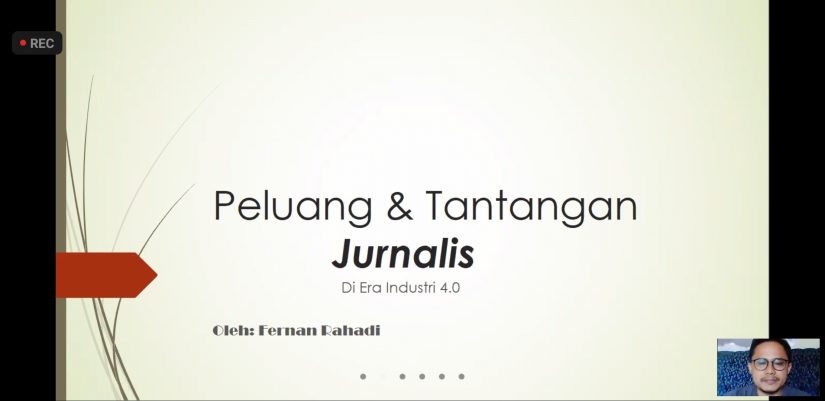
Yogyakarta, October 15th 2020—The course of Basic Journalism Program of the Undergraduate Program of Communication Science held practitioners’ lecture meetings that were open to the public. By presenting Fernan Rahadi, Daily Editor of Republika and Republika.co.id, as the guest lecturer. This meeting talked about Opportunities and Challenges of Journalists in the Multiplatform Era. The class that was held at 08.00 a.m. was moderated by one of the lecturers of the Basic Journalism course, Zainuddin Muda Z.M.
After opening the meeting with a brief explanation of the material to be delivered in this lecture, Zam as the moderator, shared a little background from Fernan. Zam then invited Fernan to immediately deliver his material. For the beginning, Fernan said that the material will focus more on the practical realm, not theoretical.
Fernan saw the multiplatform era as a further form of industry 4.0 in the media field. The emergence of multiplatform media shows a change in mindset and behavior. This can be seen from how a journalist must be able to meet the demands when deciding to enter the media industry, to not only have the ability to write, but also take photos and record sound. This change can also be seen from the types of events being reported. If in the past the news reported events that had already occurred, now it is changing to report events that are, or even will happen. It can be seen from the live reports of events that are updated every hour, even minutes. Competition between media also faded. Currently, the emphasis is on collaboration between media, such as conducting in-depth investigations together.
The presence of the internet and social media also seems like a game changer, more and more changes are felt. Fernan said that social media, which was initially not accepted by the media industry, is currently being used to spread news. The use of social media is expected to expand the reach of the audience so that a media can be accessed and known by more people. Not only that, in this context, Fernan also told stories about the momentum of social media and networking of media in democracy and politics.
From that, Fernan explained the role of social media in determining agenda settings or issues. Social media has become mainstream because many issues were raised there. In fact, conventional media also makes social media a source of issues. The appearance of buzzers and influencers on social media also has an influence on the agenda setting, because the two groups are paid to raise an issue on social media, Fernan explained.
Furthermore, Fernan explained the opportunities and threats faced by the media industry in the industrial era 4.0, the multiplatform era. Ending his presentation with a brief explanation regarding the impact of the COVID-19 pandemic on the media industry, especially journalists, Fernan also gave a quote to close this session.
Before going into the question and answer session and discussion, Zam briefly talked about some of the points he highlighted from Fernan’s explanation. Zam and several students also provided responses and questions, which were answered in detail by Fernan. After Fernan answered the last question from one of the students, Zam also invited all lecture participants to take a group photo. This open lecture ended at 09.35 a.m.
